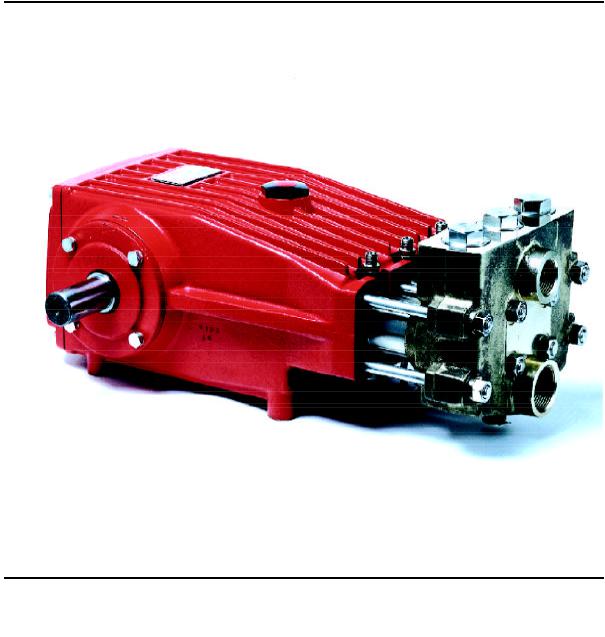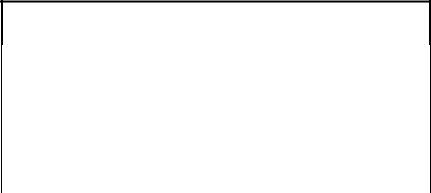HP LP450, LP350, LP400 User Manual

Triplex Ceramic
Plunger Pump
Operating Instructions/
Models Repair and Service
Manual
LP350, LP400, LP450
|
Contents: |
|
|
Installation Instructions: |
page 2 |
|
Pump Specifications: |
pages 3-5 |
|
Exploded View: |
page 6 |
|
Parts List/Kits/Torque Specs: |
page 7 |
|
Trouble Shooting Chart: |
page 8 |
|
Spare Parts List: |
page 8 |
|
Repair Instructions: |
page 9-11 |
|
Dimensions: |
back page |
Updated 2/02 |
Warranty Information: |
back page |
|
|

INSTALLATION INSTRUCTIONS
Installation of the Giant Industries, Inc., pump is not a complicated procedure, but there are some basic steps common to all pumps. The following information is to be considered as a general outline for installation. If you have unique requirements, please contact Giant Industries, Inc. or your local distributor for assistance.
1.The pump should be installed flat on a base to a maximum of a 15 degree angle of inclination to ensure optimum lubrication.
2.The inlet to the pump should be sized for the flow rate of the pump with no unnecessary restrictions that can cause cavitation. Teflon
tape should be used to seal all joints. If pumps are to be operated at temperatures in excess of 1400 F, it is important to insure a positive head to the pump to prevent cavitation.
3. The discharge plumbing from the pump should be properly sized to the flow rate to prevent line pressure loss to the work area. It is essential to provide a safety bypass valve between the pump and the work area to protect the pump from pressure spikes in the event of a blockage or the use of a shut-off gun.
4. Use of a dampener is necessary to minimize pulsation at drive elements, plumbing, connections, and other system areas. The use of a dampener with Giant Industries, Inc. pumps is optional, although recommended by Giant Industries, Inc. to further reduce system pulsation. Dampeners can also reduce the severity of pressure spikes that occur in systems using a shut-off gun. A dampener must be positioned downstream from the unloader.
5. Crankshaft rotation on Giant Industries, Inc. pumps should be made in the direction designated by the arrows on the pump crankcase. Reverse rotation may be safely achieved by following a few guidelines available upon request from Giant Industries, Inc. Required horsepower for system operation can be obtained from the charts on pages 3-5.
6. Before beginning operation of your pumping system, remember: Check that the crankcase and seal areas have been properly lubricated per recommended schedules. Do not run the pump dry for extended periods of time. Cavitation will result in severe damage. Always remember to check that all plumbing valves are open and that pumped media can flow freely to the inlet of the pump.
Finally, remember that high pressure operation in a pump system has many advantages. But, if it is used carelessly and without regard to its potential hazard, it can cause serious injury.
IMPORTANT OPERATING CONDITIONS
Failure to comply with any of these conditions invalidates the warranty.
1. Prior to initial operation, add oil to the crankcase so that oil level is between the two lines on the oil dipstick. DO NOT OVERFILL.
Use SAE 90 Industrial gear oil.
Crankcase oil should be changed after the first 50 hours of operation, then at regular intervals of 500 hours or less depending on operating conditions.
2. Pump operation must not exceed rated pressure, volume, or RPM. A pressure relief device must be installed in the discharge of the system.
3. Acids, alkalines, or abrasive fluids cannot be pumped unless approval in writing is obtained before operation from Giant Industries, Inc.
4. Run the pump dry approximately 10 seconds to drain the water before exposure to freezing temperatures.
2

|
Specifications |
Volume |
Model LP350 |
Up to 22.6 GPM |
|
Discharge Pressure ................................................................................. |
2350 PSI |
Inlet Pressure .......................................................................................... |
Up to 90 PSI |
Maximum Crankshaft Speed ................................................................... |
Up to 1000 RPM |
Plunger Diameter .................................................................................... |
30mm |
Stroke ..................................................................................................... |
42mm |
Crankcase Oil Capacity .......................................................................... |
100 fl.oz. |
Temperature of Pumped Fluids ............................................................... |
140 oF @1000 RPM |
............................................................................................................... |
160 oF Up to 500 RPM |
Inlet Port ................................................................................................ |
1-1/4" BSP+ |
Discharge Port ........................................................................................ |
1" BSP++ |
Shaft Mounting ...................................................................................... |
Either side |
Shaft Rotation ............................................................................ |
Top of pulley towards manifold |
Weight .................................................................................................... |
105 lbs. |
Crankshaft Diameter ............................................................................... |
35mm |
+ |
|
++ |
|
PULLEY INFORMATION
Pulley selection and pump speed are based on a 1725 RPM motor and "B" section belts. When selecting desired GPM, allow for a ±5% tolerance on pumps output due to variations in pulleys, belts and motors among manufacturers.
1.Select GPM required, then select appropriate motor and pump pulley from the same line.
2.The desired pressure is achieved by selecting the
correct nozzle size that corresponds with the pump GPM.
HORSEPOWER INFORMATION
Horsepower ratings shown are the power requirements for the pump. Gas engine power outputs must be approximately twice the pump power requirements shown above.
We recommend that a 1.1 service factor be specified when selecting an electric motor as the power source. To compute specific pump horsepower requirements, use the following formula:
HP = (GPM x PSI) / 1440
LP350 PULLEY SELECTION AND HORSEPOWER
REQUIREMENTS
PUMP |
MOTOR |
RPM |
GPM |
500 PSI |
1000 PSI |
2000 PSI |
2300 PSI |
PULLEY |
PULLEY |
||||||
12.75" |
3.95" |
500 |
11.3 |
3.9 |
7.8 |
15.7 |
18.0 |
12.75" |
4.95" |
640 |
14.5 |
5.0 |
10.0 |
20.1 |
23.1 |
12.75" |
5.75" |
750 |
16.9 |
5.9 |
11.8 |
23.5 |
27.1 |
12.75" |
6.15" |
805 |
18.2 |
6.3 |
12.6 |
25.3 |
29.0 |
12.75" |
6.55" |
865 |
19.5 |
6.8 |
13.6 |
27.1 |
31.2 |
12.75" |
6.95" |
940 |
21.2 |
7.4 |
14.7 |
29.5 |
33.9 |
12.75" |
7.50" |
1000 |
22.6 |
7.8 |
15.7 |
31.4 |
36.1 |
3

|
Specifications |
Volume |
Model LP400 |
Up to 15.1 GPM |
|
Discharge Pressure ................................................................................. |
3600 PSI |
Inlet Pressure .......................................................................................... |
Up to 90 PSI |
Maximum Crankshaft Speed ................................................................... |
Up to 1000 RPM |
Plunger Diameter .................................................................................... |
24mm |
Stroke ..................................................................................................... |
42mm |
Crankcase Oil Capacity .......................................................................... |
100 fl.oz. |
Temperature of Pumped Fluids ............................................................... |
140 oF @1000 RPM |
............................................................................................................... |
160 oF Up to 500 RPM |
Inlet Port ................................................................................................ |
1-1/4" BSP |
Discharge Port ........................................................................................ |
1" BSP |
Shaft Mounting ....................................................................................... |
Either side |
Shaft Rotation ............................................................................ |
Top of pulley towards manifold |
Weight .................................................................................................... |
105 lbs. |
Crankshaft Diameter ............................................................................... |
35mm |
PULLEY INFORMATION
Pulley selection and pump speed are based on a 1725 RPM motor and "B" section belts. When selecting desired GPM, allow for a ±5% tolerance on pumps output due to variations in pulleys, belts and motors among manufacturers.
1.Select GPM required, then select appropriate motor and pump pulley from the same line.
2.The desired pressure is achieved by selecting the
correct nozzle size that corresponds with the pump GPM.
HORSEPOWER INFORMATION
Horsepower ratings shown are the power requirements for the pump. Gas engine power outputs must be approximately twice the pump power requirements shown above.
We recommend that a 1.1 service factor be specified when selecting an electric motor as the power source. To compute specific pump horsepower requirements, use the following formula:
HP = (GPM x PSI) / 1440
LP400 PULLEY SELECTION AND HORSEPOWER
REQUIREMENTS
PUMP |
MOTOR |
RPM |
GPM |
2000 PSI |
2500 PSI |
3000 PSI |
3600 PSI |
PULLEY |
PULLEY |
||||||
12.75" |
3.95" |
500 |
7.5 |
10.5 |
13.1 |
15.7 |
18.8 |
12.75" |
4.95" |
640 |
9.6 |
13.4 |
16.7 |
20.1 |
24.1 |
12.75" |
5.75" |
750 |
11.3 |
15.7 |
19.6 |
23.5 |
28.2 |
12.75" |
6.15" |
805 |
12.1 |
16.8 |
21.0 |
25.3 |
30.3 |
12.75" |
6.55" |
865 |
13.0 |
18.1 |
22.6 |
27.1 |
32.6 |
12.75" |
6.95" |
940 |
14.2 |
19.7 |
24.6 |
29.5 |
35.4 |
12.75" |
7.50" |
1000 |
15.1 |
20.9 |
26.1 |
31.4 |
37.6 |
4
